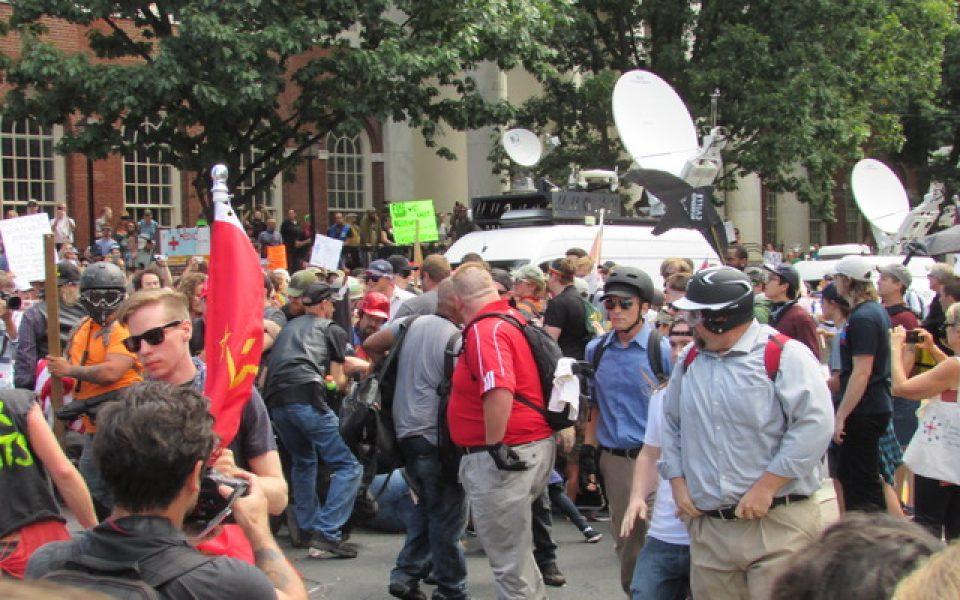There are many startling details in an independent report commissioned by the city of Charlottesville that detailed the city’s disastrous failure to protect counter-protesters and citizens during the Aug. 12 Unite the Right rally, but one stands out.
Tammy Shifflett, a school resource officer stationed alone at 4th Street NE and Market Street with no protective gear, started to feel unsafe as bands of alt-right demonstrators and counter-protesters streamed past her in the wake of the police declaring the rally an unlawful assembly, as the report, released in late November, recounts. She was relieved of her post, but commanders didn’t see fit to replace her. The oversight would have tragic consequences.
“A single wooden sawhorse was all that impeded traffic down 4th Street as large groups of people continued to roam the streets,” the report by the Hunton & Williams law firm states. “This vulnerability was exposed when James Fields drove his vehicle down the unprotected street in a large crowd of counter-protesters at the intersection of 4th Street SE and Water Street, killing Ms. [Heather] Heyer.”
Earlier in the day, as alt-right demonstrators and anti-racist counter-protesters pummeled each other in the middle of Market Street, Charlottesville police and Virginia State Troopers remained behind barricades, with one documented exception, following a plan based on the apparent assumption that counter-protesters would go to a designated area, and then paralyzed in fear as order broke down.
At one point, as detailed in the Hunton & Williams report, people attacked each other in plain view of the police after alt-right demonstrators jabbed flagpoles and then rammed through a crowd after deploying pepper spray. A woman observing the brawl turned back towards the police, as if waiting to see how they would react. Then, as noted in the report, she shouted, “This is shameful! I am a teacher, I am a community member, take care of your people. What the f*** are you doing? I am the wife of a priest, I am a teacher, I love this city! Take care of your people!”
As a consequence of multiple breakdowns, including but not limited to the failure to coordinate radio communication between Charlottesville Police Department and the Virginia State Troopers, and neglecting station officers at points where opposing demonstrators were likely to encounter each other, the report noted that “many individuals described to us a diminished confidence in law enforcement which has potentially lasting consequences for this and other communities.”
Although Charlottesville is now almost five months in the past, it stands as a profound example of the test faced by American liberal democracy.
The legitimacy of American government rests on the fragile assumption that institutions accountable to the people are capable and willing to provide protection for public safety and free speech. We already live in a country without any guarantee of protection against catastrophic illness or injury and a public education system with starkly different outcomes depending on wealth and race. When democratic institutions fail, people turn to their own devices, either through healthy impulses towards mutual aid or, fearfully, towards an authoritarian state that guarantees privileges to a favored few.
Notably, after the declaration of unlawful assembly, police in Charlottesville continued to refrain from interfering in fights, but the report notes that two Virginia State Police mobile field forces donned riot gear and took up positions to protect the Downtown Mall, a gracious pedestrian thoroughfare stuffed full of cafes, restaurants and desserteries. The message is impossible to miss.
The effective absence of coordination between law enforcement agencies tasked with protecting citizens in Charlottesville stands in marked contrast to the federally coordinated, multi-state law enforcement response to the protest movement against the Dakota Access Pipeline in late 2016. In one of the overlooked stories of 2017, the Intercept revealed that law enforcement agencies consumed intelligence on the protest movement generated by a counterterrorism firm hired to oversee security by Energy Transfer Partners, the company building the pipeline. (Incidentally, the firm, TigerSwan, was formed by a retired Army colonel and former commander in the elite Delta special operations unit and is based in Apex, NC, according to the Intercept.)
The mercenary counterterrorism firm, which quickly established an information-sharing agreement with Sheriff Dean Danzeisen in Mercer County, and placed a liaison inside the law enforcement “joint operation center” in North Dakota, perfectly exemplifies the neoliberal private security model of enhanced law enforcement at the service of oligarchy.
Most disturbingly, the TigerSwan situation reports leaked to the Intercept use language that presents supporters as enemy combatants rather than citizens. A March 1, 2017 report, according to the Intercept, stated that protesters’ “operational weakness allows TS elements to further develop and dictate the battlespace.”
Another report, a couple weeks later, made the counter-insurgency analogy even more explicit: “Much like Afghanistan and Iraq, the ‘Fighting Season’ will soon be here with the coming warming temperatures.”
Join the First Amendment Society, a membership that goes directly to funding TCB‘s newsroom.
We believe that reporting can save the world.
The TCB First Amendment Society recognizes the vital role of a free, unfettered press with a bundling of local experiences designed to build community, and unique engagements with our newsroom that will help you understand, and shape, local journalism’s critical role in uplifting the people in our cities.
All revenue goes directly into the newsroom as reporters’ salaries and freelance commissions.





Leave a Reply